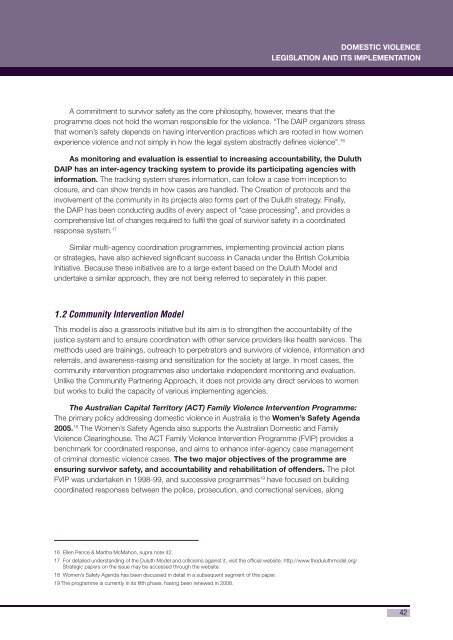Domestic Violence Legislation and its Implementation
Domestic Violence Legislation and its Implementation
Domestic Violence Legislation and its Implementation
You also want an ePaper? Increase the reach of your titles
YUMPU automatically turns print PDFs into web optimized ePapers that Google loves.
DOMESTIC VIOLENCE<br />
LEGISLATION AND ITS IMPLEMENTATION<br />
A commitment to survivor safety as the core philosophy, however, means that the<br />
programme does not hold the woman responsible for the violence. “The DAIP organizers stress<br />
that women’s safety depends on having intervention practices which are rooted in how women<br />
experience violence <strong>and</strong> not simply in how the legal system abstractly defi nes violence”. 16<br />
As monitoring <strong>and</strong> evaluation is essential to increasing accountability, the Duluth<br />
DAIP has an inter-agency tracking system to provide <strong>its</strong> participating agencies with<br />
information. The tracking system shares information, can follow a case from inception to<br />
closure, <strong>and</strong> can show trends in how cases are h<strong>and</strong>led. The Creation of protocols <strong>and</strong> the<br />
involvement of the community in <strong>its</strong> projects also forms part of the Duluth strategy. Finally,<br />
the DAIP has been conducting aud<strong>its</strong> of every aspect of “case processing”, <strong>and</strong> provides a<br />
comprehensive list of changes required to fulfi l the goal of survivor safety in a coordinated<br />
response system. 17<br />
Similar multi-agency coordination programmes, implementing provincial action plans<br />
or strategies, have also achieved signifi cant success in Canada under the British Columbia<br />
Initiative. Because these initiatives are to a large extent based on the Duluth Model <strong>and</strong><br />
undertake a similar approach, they are not being referred to separately in this paper.<br />
1.2 Community Intervention Model<br />
This model is also a grassroots initiative but <strong>its</strong> aim is to strengthen the accountability of the<br />
justice system <strong>and</strong> to ensure coordination with other service providers like health services. The<br />
methods used are trainings, outreach to perpetrators <strong>and</strong> survivors of violence, information <strong>and</strong><br />
referrals, <strong>and</strong> awareness-raising <strong>and</strong> sensitization for the society at large. In most cases, the<br />
community intervention programmes also undertake independent monitoring <strong>and</strong> evaluation.<br />
Unlike the Community Partnering Approach, it does not provide any direct services to women<br />
but works to build the capacity of various implementing agencies.<br />
The Australian Capital Territory (ACT) Family <strong>Violence</strong> Intervention Programme:<br />
The primary policy addressing domestic violence in Australia is the Women’s Safety Agenda<br />
2005. 18 The Women’s Safety Agenda also supports the Australian <strong>Domestic</strong> <strong>and</strong> Family<br />
<strong>Violence</strong> Clearinghouse. The ACT Family <strong>Violence</strong> Intervention Programme (FVIP) provides a<br />
benchmark for coordinated response, <strong>and</strong> aims to enhance inter-agency case management<br />
of criminal domestic violence cases. The two major objectives of the programme are<br />
ensuring survivor safety, <strong>and</strong> accountability <strong>and</strong> rehabilitation of offenders. The pilot<br />
FVIP was undertaken in 1998-99, <strong>and</strong> successive programmes 19 have focused on building<br />
coordinated responses between the police, prosecution, <strong>and</strong> correctional services, along<br />
16 Ellen Pence & Martha McMahon, supra note 42.<br />
17 For detailed underst<strong>and</strong>ing of the Duluth Model <strong>and</strong> criticisms against it, visit the offi cial website. http://www.theduluthmodel.org/<br />
Strategic papers on the issue may be accessed through the website.<br />
18 Women’s Safety Agenda has been discussed in detail in a subsequent segment of this paper.<br />
19 The programme is currently in <strong>its</strong> fi fth phase, having been renewed in 2008.<br />
42

















